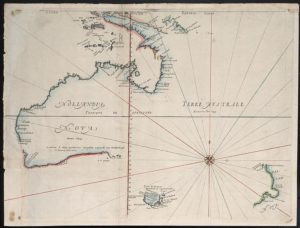
The first English vessel to visit, when attempting to sail the Dutch-established Brouwer Route to the Indies, was Tryall, an East India Company-owned East Indiaman under the command of John Brookes who in 1622 sighted Point Cloates before later on 25 May wrecking on Tryal Rocks, off the northwest coast of Australia. Some of the 143 crew remained on the Monte Bello Islands for 7 days, during that time sighting Barrow Island, before sailing to Batavia in a longboat. A second boat brought some more crew to Batavia, so just over 40 people survived, including Brookes. Almost one hundred crew apparently perished in the wreck. Tryall became Australia’s oldest known shipwreck.
A later English visitor was William Dampier, who in 1699 sailed down some of the western coast of Australia. He noted the lack of water and in his description of Shark Bay in his account “A Voyage to New Holland“, he expressed his frustration: as the 7th of August when we came into Shark’s Bay; in which we Anchored at three several Places, and stay’d at the first of them (on the W. side of the Bay) till the 11th. During which time we searched about, as I said, for fresh Water, digging Wells, but to no purpose.”
Colonial Era:
The first formal claim of possession for Great Britain was made on 29 September 1791 by Commander (later Captain) George Vancouver RN, on a spot he named Possession Point, at the tip of the peninsula between the waters he also named Princess Royal Harbour and King George the Third’s Sound at Albany (“the Third” was dropped from the name in 1826).
In the early 19th century the British became concerned about the possibility of a French colony being established on the west coast of Australia. In 1826 the Governor of New South Wales, Ralph Darling, ordered the establishment of a settlement at King George’s Sound. An army detachment was sent from Sydney headed by Major Edmund Lockyer with eighteen soldiers, one captain, one doctor, one storekeeper and twenty-three convicts.

On 21 January 1827 the whole of Australia was finally claimed as British territory when Major Lockyer formally annexed the western portion of the continent in a ceremony on King George Sound.
In March 1831 the penal settlement was withdrawn, and the control of King George’s Sound was transferred from New South Wales to the Swan River Colony. Captain James Stirling decreed that the settlement would be named “Albany” from 1 January 1832.
The Swan River Colony:
The first significant European settlements were established on the Swan River by James Stirling in 1829. The colonists first sighted land on 1 June, an official Proclamation was made on 18 June and the foundation of the colony took place on 12 August. As Lieutenant Governor, Stirling had sole authority to draft laws and decide day-to-day affairs.
By 1859, all the other Australian colonies had their own parliaments and colonists in Western Australia began pushing for the right to govern themselves. The British Colonial Office opposed this because of the slow rate of growth and the presence by then of convicts. Petitions asking for some of the positions in the Legislative Council to be filled by popularly elected colonists were presented to London in 1865 and 1869. In 1870 this was granted, although the Governor could still veto the Council’s decisions.
